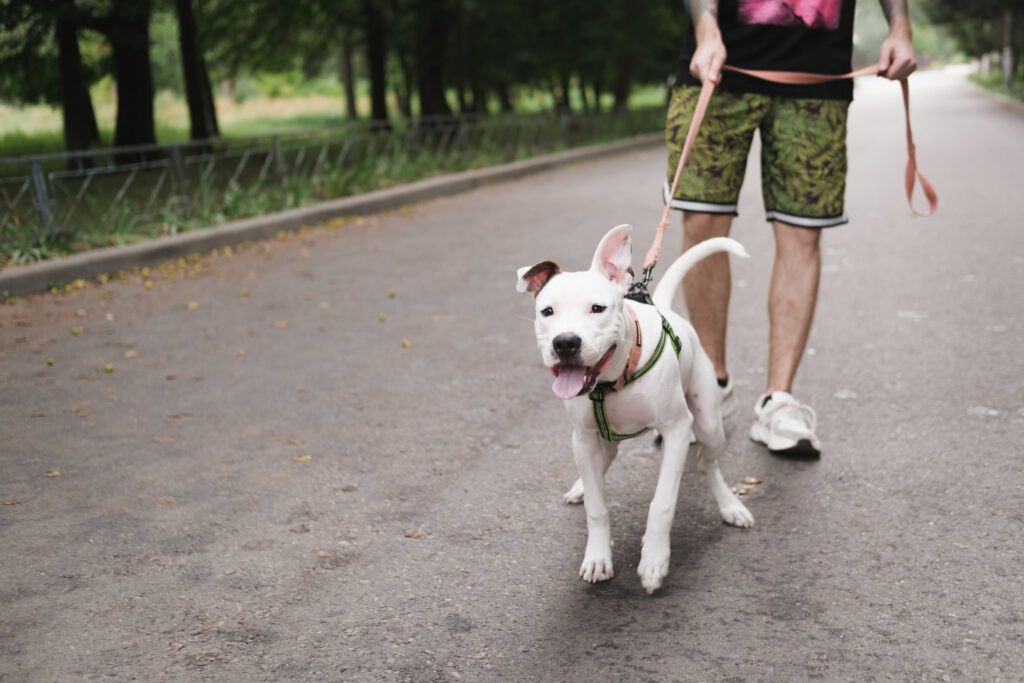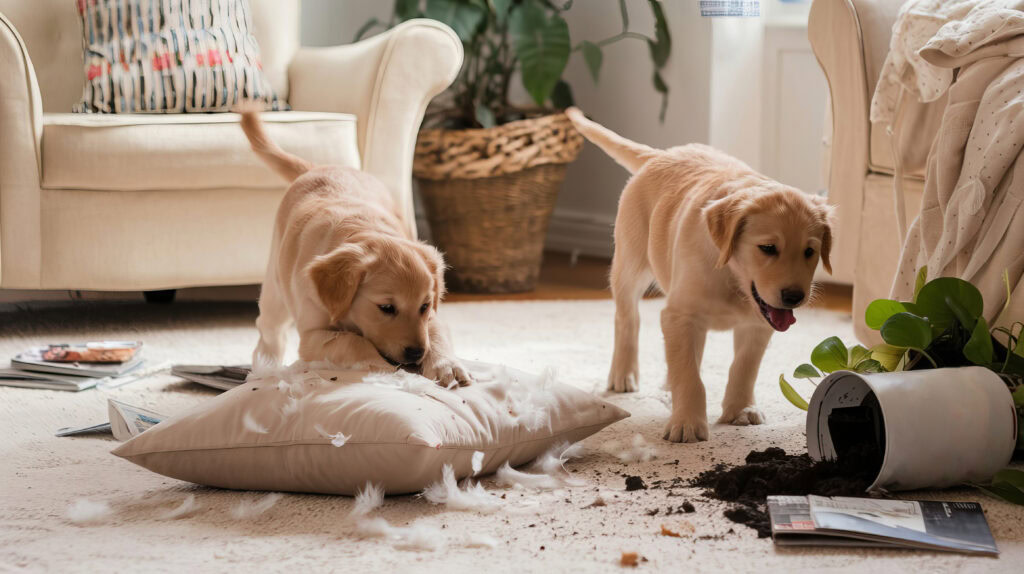5 Methods to Train a Hyperactive Dog
Does your dog bounce off the walls, struggle to sit still, or seem impossible to tire out? You’re not alone in dealing with a hyperactive pup who turns every moment into chaos.
Training a hyperactive dog requires understanding their energy needs, using consistent techniques, and channelling their excess energy into productive activities. The key lies in working with your dog’s natural drive rather than against it.
5 Methods to Train a Hyperactive Dog
- Increase Physical Exercise – Give your hyperactive dog 60–90 minutes of vigorous daily activity to burn off excess energy.
- Engage in Mental Stimulation – Use puzzle toys, training games, and scent work to challenge your dog’s mind and reduce restlessness.
- Teach Impulse Control – Train commands like “wait” and “stay” to help your dog pause and think before acting.
- Use Short, Frequent Training Sessions – Keep lessons 5–10 minutes long and repeat them throughout the day for better focus.
- Create a Calm Environment – Reduce household distractions and provide quiet zones to help your dog settle.
Understanding Canine Hyperactivity
Hyperactive dogs show more energy than normal dogs of their age and breed. They often cannot settle down or focus on tasks for long periods.
Common signs include jumping, pacing, excessive barking, and difficulty following commands. Your dog might also struggle to sleep properly or seem restless most of the time.
Several factors cause hyperactive behaviour in dogs:
- Lack of exercise – Dogs need daily physical activity to burn energy
- Physical and mental stimulation shortage – Bored dogs often become overactive
- Anxiety or stress – Nervous dogs may pace or act restless
- Medical issues – Some health problems increase activity levels
- Poor training – Dogs without structure often develop bad habits
Young dogs naturally have more energy than older ones. Puppies and adolescent dogs are typically more active and playful.
Breed matters too. Working breeds like Border Collies and German Shepherds need more exercise than lap dogs. These breeds were bred to work all day.
Diet can affect your dog’s energy levels. Foods high in sugar or certain additives might make some dogs more active.
Your dog’s environment also plays a role. Dogs left alone for long periods often become hyperactive when their owners return home.
Identifying the root cause helps you choose the right training approach. A tired dog from lack of exercise needs different help than an anxious dog.
Professional trainers can assess your dog’s specific situation. They look at age, breed, health, and daily routine to understand the hyperactive behaviour.
5 Essential Strategies for Training a Hyperactive Dog
Training a high-energy dog requires specific techniques that address their excess energy and impulsive behaviours. The most effective approach combines increased physical activity, mental challenges, impulse control training, shorter sessions, and environmental management.
1. Increase Physical Exercise
Hyperactive dogs need more physical activity than the average pet. Most high-energy breeds require at least 60-90 minutes of vigorous exercise daily.
Running, hiking, and swimming provide excellent outlets for excess energy. These activities tire your dog’s body and help reduce hyperactive behaviours indoors.
Daily Exercise Schedule:
- Morning: 30-45 minutes of vigorous activity
- Afternoon: 15-20 minutes of moderate play
- Evening: 15-30 minutes of walking or light activity
Fetch games work particularly well for hyperactive dogs. Use a tennis ball or frisbee in a large, secure area where your dog can run freely.
Dog sports like agility training channel hyperactivity into structured activities. Your dog learns to focus their energy while following commands and building confidence.
2. Engage in Mental Stimulation
Mental exercise exhausts hyperactive dogs as effectively as physical activity. Puzzle toys, training games, and problem-solving activities engage their minds and reduce restless behaviour.
Food puzzles make mealtimes more challenging and rewarding. Hide treats around your home or use puzzle feeders that require manipulation to release food.
Effective Mental Stimulation Activities:
- Scent work: Hide treats for your dog to find
- Training new tricks: Teach complex commands like “roll over” or “play dead”
- Interactive toys: Use toys that dispense treats when manipulated
- Obedience practice: Regular training sessions reinforce good behaviour
Rotate mental stimulation activities weekly to maintain your dog’s interest. Bored dogs often become more hyperactive and destructive.
3. Teach Impulse Control
Impulse control training helps hyperactive dogs learn to pause and think before acting. This reduces problematic behaviours like jumping on people or grabbing items inappropriately.
Start with basic “wait” and “stay” commands during feeding time. Make your dog sit calmly before placing their food bowl down.
Key Impulse Control Exercises:
- Door manners: Your dog must sit before going outside
- Greeting control: No jumping on people until given permission
- Resource patience: Waiting for toys or treats on command
Use positive reinforcement when your dog shows self-control. Reward calm behaviour immediately with treats, praise, or play.
Practice impulse control in different locations and situations. This helps your dog generalise the behaviour beyond your home environment.
4. Use Short, Frequent Training Sessions
Hyperactive dogs have shorter attention spans than calmer breeds. Keep training sessions between 5-10 minutes to maintain focus and prevent frustration.
Conduct multiple short sessions throughout the day rather than one long session. This approach suits your dog’s energy levels and learning style better.
Optimal Training Schedule:
- Morning session: 5-7 minutes after exercise
- Midday session: 3-5 minutes during calm periods
- Evening session: 5-8 minutes before dinner
End each session on a positive note with a command your dog knows well. This builds confidence and maintains enthusiasm for future training.
Use high-value treats during training sessions to keep your hyperactive dog engaged. Small, soft treats work best as they can be eaten quickly without interrupting the flow.
5. Create a Calm Environment
Your home environment significantly impacts your dog’s behaviour levels. Reducing stimulation helps hyperactive dogs settle and focus better during training.
Establish quiet zones where your dog can retreat when feeling overwhelmed. Use baby gates to create boundaries and provide structure throughout your home.
Environmental Management Tips:
- Lower television and music volume during training
- Remove exciting toys during calm periods
- Use blackout curtains to reduce visual distractions
- Provide comfortable bedding in quiet areas
Maintain consistent daily routines for feeding, exercise, and training. Predictable schedules help hyperactive dogs feel more secure and less anxious.
Consider using calming treats or aids like pheromone diffusers or anxiety wraps during particularly stimulating periods. These tools support your training efforts without replacing proper exercise and mental stimulation.

Walking with an active dog on the leash. Man walks his happy staffordshire terrier puppy outdoors
Building Consistency and Long-Term Success
Training a hyperactive dog requires steady daily routines and methods that match your dog’s specific needs. Keeping track of your dog’s progress helps you see what works and when you might need expert help.
Establishing Reliable Routines
Your hyperactive dog needs the same schedule every single day. Feed your dog at the exact same times each morning and evening. Take walks at consistent hours so your dog knows what to expect.
Set up training sessions at regular intervals throughout the day. Short 5-minute sessions work better than long ones for hyperactive dogs. Pick the same spots in your home for these training sessions.
Create a bedtime routine that never changes. This might include a final toilet break, turning off lights, and settling your dog in their sleeping area. Your dog will learn to calm down when they recognise these signals.
Keep all family members following the same rules. If you don’t allow jumping on the couch, everyone must enforce this rule. Mixed messages confuse hyperactive dogs and slow down their progress.
Adapting to Your Dog’s Temperament
Some hyperactive dogs respond better to mental challenges than physical exercise. Try puzzle toys or scent work if your dog seems bored after long walks. Other dogs need more running and playing to tire them out properly.
Watch how your dog reacts to different training methods. Food rewards work well for most dogs, but some respond better to toy rewards or praise. Change your approach based on what motivates your specific dog.
Notice when your dog has the most energy during the day. Schedule training sessions during these high-energy periods rather than fighting against them. You can teach better focus when you work with your dog’s natural patterns.
Adjust your expectations based on your dog’s age and breed. Young dogs under two years old often have more energy than older dogs. Some breeds naturally have higher activity levels that you need to manage rather than eliminate completely.
Tracking Progress and Seeking Professional Support
Write down your dog’s behaviour each day in a simple notebook. Note how long your dog can focus during training and any problem behaviours you observe. This helps you spot patterns and improvements over time.
Take weekly videos of your training sessions. Comparing videos from different weeks shows progress that you might miss day-to-day. These videos also help professional trainers understand your dog’s specific challenges.
Contact a qualified dog trainer if you see no improvement after six weeks of consistent training. Look for trainers who use balanced methods and have experience with hyperactive dogs. Professional help can identify problems you might be missing.
Book a vet check if your dog’s hyperactivity suddenly gets worse or includes new symptoms. Some medical conditions can cause hyperactive behaviour that training alone cannot fix.
Learn How to Train A Hyperactive Dog with Allbreeds! Contact Us Today!
At Allbreeds, we understand that every hyperactive dog has unique needs, and we tailor our training programs to channel their energy into positive, manageable behaviours. Using proven methods that combine physical exercise, mental stimulation, and consistent routines, our experienced trainers can help transform your energetic pup into a well-mannered companion. Don’t let excessive energy become a daily struggle.
Contact us today and discover how the right training can bring balance and calm to your dog’s life.


